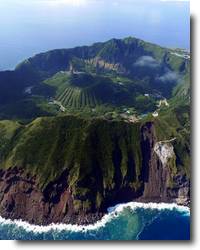The meaning of the names of Japan's provinces
47 provinces in an area with only 377,900 square kilometers. Just to get an idea, Brazil is 22.5 times greater than the Japanese territory (8,516,000 square kilometers), and has fewer federal units that Japan (26 states and one federal district).
But have you ever wondered what is the meaning of these provinces? Understand today these meanings and their origin and history, this special edition of Kanto!
Kanto region
1 - Ibaraki Province - 茨城 県
Second in Ibaraki county article book Hitachinokuni Fudoki ( 常陸国風土記 ), which means something like topography of Hitachinokuni (one of the old provinces of Japan's former Local Government District system), to stop the thieves who roamed the region they created a thorn fence around the castle. In deed, he was noted as something "to stop thieves from Saeki who lived in a hole and threatened the inhabitants of the region, made a trap of thorns and pressed thieves for this trap."
In Japanese, Ibara means "thorn" and Ki "castle".
In another theory, according to the book Man'yōshū ( 万葉集 ), the oldest collection of Japanese poetry compiled in 759 AD during the Nara period, there is a song that says: "As a vineyard full of beans thorny branches on the roadside, lamenting the sad farewell, he had to go on the road and leave his wife. "
2 - Province of Tochigi - 栃 木 県
We can divide into four theories:
1 - In the old Tochigi neighborhood (present city of Tochigi), there was a shrine called Shinmeiguu ( 神明宮 ), which had two "Chigi" ( 千木 ) and 8 "Katsuogi" ( 鰹木 ) on the roof of the temple (picture below ). When seen from a distance, they look like a single set of 10 units, which gave its name to the region, which would be considered 十千木 (Toochigi), which would be 10 "Chigi".
2 - According to this theory, the name of the province came because of the abundance of trees "Tochinoki" ( 栃の木 ), which in Portuguese is "Chestnut guinea Japanese." Once the name has been reduced to "Tochigi".
3 - In the old Tochigi neighborhood (present city of Tochigi), there was a lake called Uzuma, which in turn caused flooding, and because of that, these lands became known as "land eroded" in Japanese "Chiguireta Chikei" ( 千切れた地形 ). And then they added the prefix "To" in the verb "Chigui (ru)."
4 - According to the book Kojiki or Furukotofumi ( 古事記 ), the oldest book about ancient Japan, there were two kingdoms with the same name: the "Ki no Kuni" ( 木/毛の国 ), current province of Tochigi, and the " Ki no Kuni "( 木/ 紀の国 ), current province of Wakayama. In order to differentiate between the two kingdoms, Prince Toyokiiri Bikonomikoto (豊城入彦命 ) named the first "Ki no Kuni" and "Tootsuki" ( 遠津木 ), which means "the country of distant trees," and then was reduced to " Tochigi ".
3 - Gunma Prefecture - 群 馬 県
If we go back some 1300 years in time, according to the documents of the ancient castle of Fujiwara, within the Gunma prefecture, had a region known as "Kurumahyou" ( 車評 ), or Kuruma county.
Early in the Nara era in the sixth year of Wado period (713 AD), in a topography of the book edict of certain regions, Kofudoki ( 古風土記 ), all kingdoms, counties and capitals would have to change their names to two kanji . Therefore, the "Kurumahyou" turned "Gunma".
"Gunma" comes from the large number of horse breeding, which were seen as animals that showed authority, a symbol of wealth. "Gunma" means something like "herd of horses."
4 - Saitama - 埼 玉 県
One theory says that the birthplace of the province's name comes from the village of "Sakitama" shire "Kitasaitama" current Ōazasakitama neighborhood of the city of Gyouda.
There are many other theories as to the origin have come from Sakitama tombs, or that says the name refers to the work of a God who brings happiness, called 幸魂 (Sakimitama).
In Man'yōshū (book 万葉集 ), there were descriptions of the county that received the names of "Sakitama" ( 前玉 ) and "Sakitama" ( 佐吉多万 ). Also in the book Wamyouruijushou ( 和名類聚抄 ), written in the years 931-938, there were records of the name "Saitama" ( 埼玉 ) and "Saitama" ( 佐伊太末 ).
5 - Chiba Province - 千葉 県
The date on which it was decided name is not well determined, but it is known that before the Ritsuryou system, the name of the governor at the time was the kokuzou Chiha ( 千葉国造 ), then the Ritsuryou system, the region was known as the county of Chiba. There are several theories for the name of the region, but according to one theory, the name of the region comes from the large number of sheets in the region, which has the following:
- It shows a land with a lot of fertility
- Because it has several meadows with lush vegetation
- A place where they prayed for the prosperity of the land and of the descendants of this.
6 - Tokyo Province - 東京 都
The name of the province, according to the book 江戸ヲ称シテ東京ト 為スノ詔(EdowoshōshiteTōkyōtonasunoshōsho) released the first year of the Meiji Era (September 1868), came when the province of Tokyo ( 東京府 ), which ministered areas magistrate (system implemented in the government of Edo) was built.
The "Kyo" ( 京 ) Tokyo means capital, and "Higashi" East, which means something like "Eastern capital", and was the city of Kyoto ( 京都 ) located in the east of the country.
7 - Kanagawa Prefecture - 神奈川 県
Previously, Kanagawa was also written as 神奈河 , 神名川 , 上無川 and others. When there was the system of decrees countries had the Kuraki county, located in Musashinokuni ( 武蔵国 ) - Current Kanagawa district, Yokohama- that was used since ancient times as an important land and sea route.
This became the name of the city when the sixth year of Ansei (1859), there was the opening of the port of Yokohama and the installation of the "Kanagawa Magistrate's Office" ( 神奈川奉行所 ). And in September of the first year of the Meiji era (1868), the province was defined as 神奈川 .
This is the continuation of s
Source: Naver Matome



Comentários